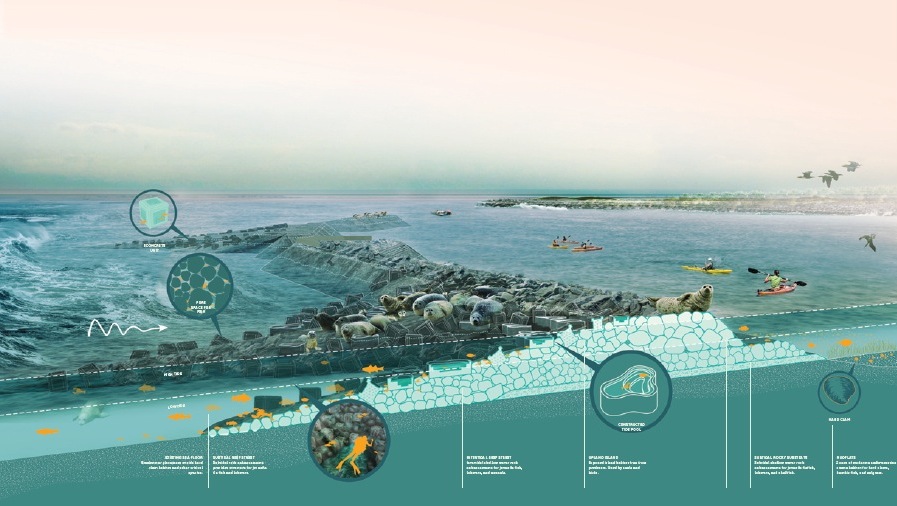New York-based landscape architecture firm SCAPE won the Buckminster Fuller Institute’s 2014 Fuller Challenge, billed as socially responsible design’s highest award.
The development project, Living Breakwaters, is a climate change adaptation plan. A 2014 Fuller Challenge senior advisor and jury member, Bill Browning of Terrapin Bright Green, said about the project: “Living Breakwaters is about dissipating and working with natural energy rather than fighting it. It is on the one hand an engineering and infrastructure-related intervention, but it also has a unique biological function as well. The project team [understands] that you cannot keep back coastal flooding in the context of climate change, but what you can do is ameliorate the force and impact of 100 and 500 year storm surges to diminish the damage through ecological interventions, while simultaneously catalyzing dialog to nurture future stewards of the built environment.”
According to SCAPE, Living Breakwaters “reduces risk, revives ecologies, and connects educators to the shoreline, inspiring a new generation of harbor stewards and a more resilient region over time.”
This is accomplished through a series of projects, including designing “reef street” micro-pockets of habitat complexity to host finfish, shellfish, and lobsters.
A release from the Buckminster Fuller Institute explains that the Living Breakwaters project "integrates components ranging from ecologically engineered ‘Oystertecture,’ to transformational education around coastal resiliency and the restoration of livelihoods traditional to the community of Tottenville in state Island,” while also encouraging systemic change in regulatory pathways at the state level.
Fuller Challenge's Program Manager Sarah Skenazy said, "This year’s Challenge winners deeply know that doing a physical intervention off the coastline would not be enough to create systemic change. Living Breakwaters is a project based in connections—the leadership team brings their deep expertise in technology and ecological science into the social dimension onshore in partnership with the community itself."
On winning the award, SCAPE’s Kate Orff said, "We are so honored to be the 2014 Fuller Challenge recipient. Fuller was optimistic about the future of humanity and deeply believed in cooperation as the way forward. As climate change impacts threaten shoreline populations, Living Breakwaters hopefully represents a paradigm shift in how we collectively address climate risks, by focusing on regenerating waterfront communities and social systems, and enhancing threatened ecosystems."
Orff will accept the Fuller Challenge prize and a $100,000 cash award on behalf of SCAPE at The Wythe in Brooklyn, N.Y., on November 20.
Learn more about the project at SCAPE.







